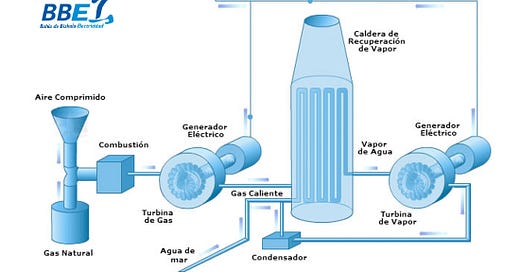59) Central de Ciclo Combinado: Caso de Estudio Bahía Bizkaia Electricidad (BBE)
Con la aparición de la guerra en el continente europeo hemos tomado conciencia de la importancia que tiene el gas natural en nuestras vidas. Además de usarse en el ámbito residencial e industrial, el gas natural se emplea en la generación eléctrica en los ciclos combinados. Analizaré la instalación de 785 MW de Bahia de Bizkaia Electricidad S.L. (75% bp -25% Energiaren Euskal Erakundea / Ente Vasco de la Energía) en el puerto de Bilbao.
La planta, creada en 2003, basa su actividad en una configuración “2 x 1”, con 2 turbinas de gas MS 9001 FA de General Electric GE (nº1 256,6 MW / nº2 257,4 MW), 2 calderas de recuperación de circulación natural y 3 niveles de presión de Babcock & Wilcox Española y 1 turbina de vapor de tres cuerpos (271,3 MW), con recalentamiento intermedio de General Electric.
La central consume gas natural a una presión mínima de 35 bar, suministrado por la planta de regasificación de Bahía de Bizkaia Gas S.L. en las instalaciones contiguas (aquí como funciona la regasificación de GNL https://lnkd.in/dFP3-HB3).
Por describir el proceso, el gas natural se mezcla con aire a presión produciendo la combustión y haciendo girar la turbina de gas, debido a la expansión de los gases de la combustión. Para llegar a una eficiencia superior al 55%, el gas natural se precalienta empleando el agua extraída de las calderas de recuperación.
Por otra parte, los gases calientes, remanentes de la combustión se aprovechan para calentar agua y convertirla en vapor en un recuperador de calor. Este vapor generado se dirige a la turbina de vapor para generar más electricidad, de ahí su nombre de ciclo combinado. La optimización del ciclo de vapor, basada en altas condiciones de temperatura en vapor vivo y recalentado caliente, así como altos niveles de vacío del condensador.
Al estar situado en el puerto, la refrigeración, tanto del condensador como del circuito cerrado de refrigeración, se realiza mediante un circuito abierto de agua de mar.
A medida que las energías renovables se implanten en el mix energético del país, los ciclos combinados se convertirán en esenciales para dar una rápida respuesta ante el aumento de la demanda. Esa rápida respuesta es posible gracias a los by-passes del 100% permiten el arranque individual de turbina de gas y caldera de recuperación, sin necesidad de arrancar la turbina de vapor.
Los generadores han transformado la energía mecánica en energía eléctrica, y esa electricidad producida a 15,75 kV, es elevada por los 3 transformadores principales a 400 kV para ser volcada en la red de transporte de Red Eléctrica de España (REE).
De este “sencillo” modo, una central de ciclo combinado aprovecha la energía térmica del combustible para proporcionarnos electricidad a nuestro día a día, mediante 2 ciclos termodinámicos (Ciclo Brayton en la combustión y ciclo Rankine en la turbina de vapor).
59) Combined Cycle Power Plant: Case of Study Bahía Bizkaia Electricidad (BBE)
With the outbreak of war on the European continent, we have become aware of the importance of natural gas in our lives. In addition to being used in the residential and industrial fields, natural gas is used in electricity generation in combined cycles. I will analyze the 785 MW installation of Bahia de Bizkaia Electricidad S.L. (75% bp -25% Energiaren Euskal Erakundea / Basque Energy Entity) in the port of Bilbao.
The plant, created in 2003, bases its activity on a "2 x 1" configuration, with 2 General Electric GE MS 9001 FA gas turbines (#1 256.6 MW / #2 257.4 MW), 2 heat recovery boilers, natural circulation and 3 pressure levels from Babcock & Wilcox Española and 1 steam turbine with three bodies (271.3 MW), with intermediate reheating from General Electric.
The plant consumes natural gas at a minimum pressure of 35 bar, supplied by the regasification plant of Bahía de Bizkaia Gas S.L. in the adjacent facilities (here how LNG regasification works https://lnkd.in/dFP3-HB3).
To describe the process, natural gas is mixed with air under pressure, producing combustion and turning the gas turbine, due to the expansion of the combustion gases. To reach an efficiency greater than 55%, the natural gas is preheated using the water extracted from the recovery boilers.
On the other hand, the hot gases remaining from the combustion are used to heat water and convert it into steam in a heat recovery unit. This generated steam is directed to the steam turbine to generate more electricity, hence its name combined cycle. The optimization of the steam cycle, based on high temperature conditions in live and hot superheated steam, as well as high levels of condenser vacuum.
Being located in the port, the cooling, both of the condenser and of the closed cooling circuit, is carried out by means of an open circuit of seawater.
As renewable energies are implemented in the country's energy mix, combined cycles will become essential to give a rapid response to the increase in demand. This rapid response is possible thanks to the 100% by-passes that allow the individual starting of the gas turbine and recovery boiler, without the need to start the steam turbine.
The generators have transformed mechanical energy into electrical energy, and this electricity produced at 15.75 kV is elevated by the 3 main transformers to 400 kV to be fed into the transmission network of Red Eléctrica de España (REE).
In this "simple" way, a combined cycle power plant uses the thermal energy of the fuel to provide electricity for our day to day, through 2 thermodynamic cycles (Brayton cycle in combustion and Rankine cycle in the steam turbine).






